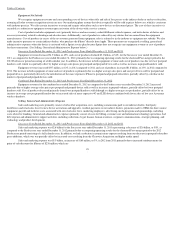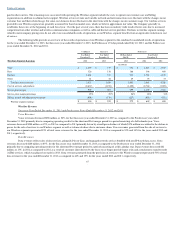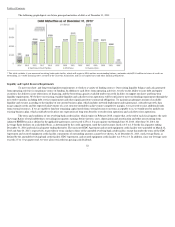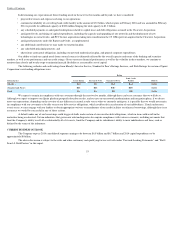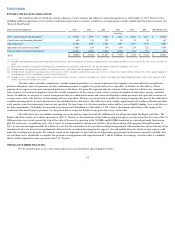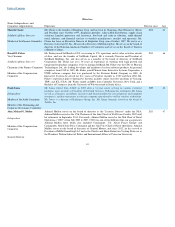Sprint - Nextel 2013 Annual Report Download - page 57
Download and view the complete annual report
Please find page 57 of the 2013 Sprint - Nextel annual report below. You can navigate through the pages in the report by either clicking on the pages listed below, or by using the keyword search tool below to find specific information within the annual report.
Table of Contents
CRITICAL ACCOUNTING POLICIES AND ESTIMATES
Sprint applies those accounting policies that management believes best reflect the underlying business and economic events, consistent with U.S.
GAAP. Sprint's more critical accounting policies include those related to the basis of presentation, allowance for doubtful accounts, valuation and recoverability
of our equity method investment in Clearwire prior to the acquisition of the remaining equity interests on July 9, 2013, valuation and recoverability of long
-
lived
assets, and evaluation of goodwill and indefinite
-
lived assets for impairment. Inherent in such policies are certain key assumptions and estimates made by
management. Management regularly updates its estimates used in the preparation of the financial statements based on its latest assessment of the current and
projected business and general economic environment. These critical accounting policies have been discussed with Sprint's Board of Directors. Sprint's
significant accounting policies and estimates are summarized in the Notes to the Consolidated Financial Statements.
Allowance for Doubtful Accounts
We maintain an allowance for doubtful accounts for estimated losses that result from failure of our subscribers to make required payments. Our
estimate of the allowance for doubtful accounts considers a number of factors, including collection experience, aging of the accounts receivable portfolios,
credit quality of the subscriber base, and other qualitative considerations. To the extent that actual loss experience differs significantly from historical trends,
the required allowance amounts could differ from our estimate. A 10% change in the amount estimated to be uncollectible would result in a corresponding
change in bad debt expense of approximately $16 million for the Wireless segment and was immaterial for the Wireline segment.
Valuation and Recoverability of Long
-
lived Assets
Long
-
lived assets consist primarily of property, plant and equipment and intangible assets subject to amortization. Changes in technology or in our
intended use of these assets, as well as changes in economic or industry factors or in our business or prospects, may cause the estimated period of use or the
value of these assets to change.
Property, plant and equipment are generally depreciated on a straight
-
line basis over estimated economic useful lives. Certain network assets are
depreciated using the group life method. Depreciable life studies are performed periodically to confirm the appropriateness of depreciable lives for certain
categories of property, plant and equipment. These studies take into account actual usage, physical wear and tear, replacement history and assumptions about
technology evolution. When these factors indicate that an asset's useful life is different from the previous assessment, we depreciate the remaining book values
prospectively over the adjusted remaining estimated useful life. Depreciation rates for assets using the group life method are revised periodically as required
under this method. Changes made as a result of depreciable life studies and rate changes generally do not have a material effect on depreciation expense.
Long
-
lived assets are reviewed for impairment whenever events or changes in circumstances indicate that the carrying amount may not be
recoverable. Long
-
lived asset groups were determined based upon certain factors including assessing the lowest level for which identifiable cash flows are
largely independent of the cash flows of other groups of assets and liabilities. If the total of the expected undiscounted future cash flows is less than the
carrying amount of our assets, a loss is recognized for the difference between the estimated fair value and carrying value of the assets. Impairment analyses,
when performed, are based on our current business and technology strategy, views of growth rates for our business, anticipated future economic and
regulatory conditions and expected technological availability. Our estimate of undiscounted cash flows exceeded the carrying value of these assets by
approximately 10%. If we experience significant operational challenges, including retaining and attracting subscribers, future cash flows of the Company may
not be sufficient to recover the carrying value of our wireless asset group, and we could record asset impairments that are material to Sprint's consolidated
results of operations and financial condition.
In addition to the analysis described above, certain assets that have not yet been deployed in the business, including network equipment, cell site
development costs and software in development will be expensed if events or changes in circumstances cause the Company to conclude the assets are no
longer needed to meet management's strategic plans and are no longer probable of being deployed. Refer to Results of Operations for additional information on
asset impairments.
55


